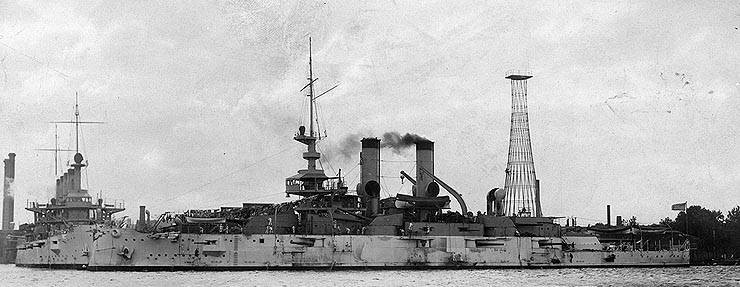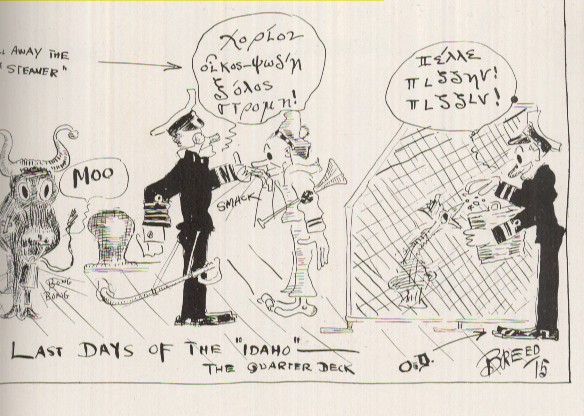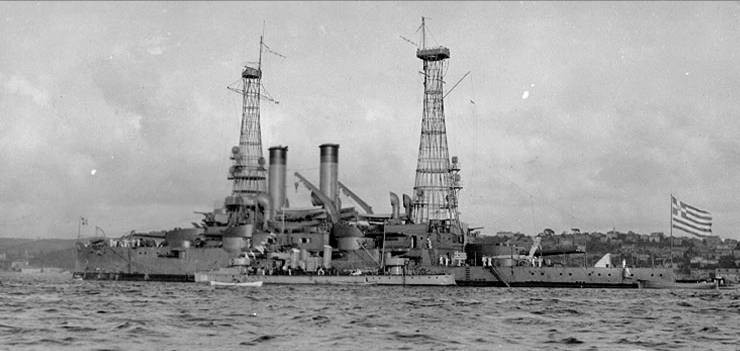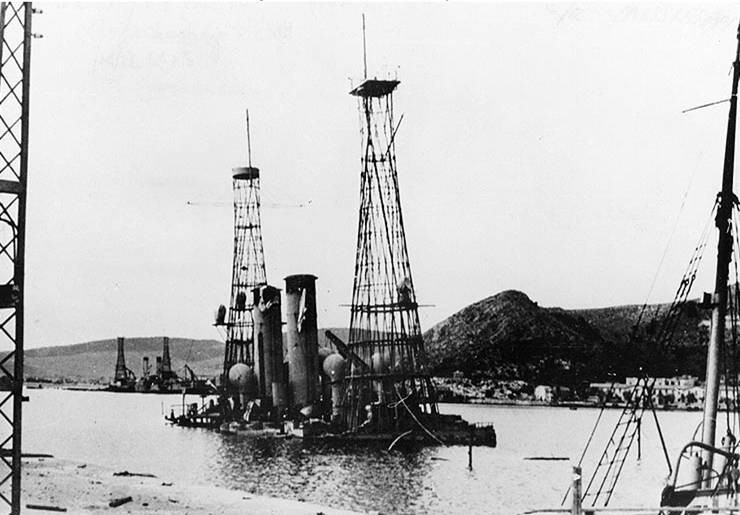Idaho II (Battleship No. 24)
1908-1914

(Battleship No. 24: displacement 14,465 (full load), 13,000 (normal); length 382'0"; beam 77'0"; draft 24'8" (mean, normal); speed 17 knots; complement 836; armament 4 12-inch, 8 8-inch, 8 7-inch, 12 3-inch, 2 1-pounders, 6 .30 caliber machine guns, 2 21-inch torpedo tubes (submerged); class Mississippi)

The 43d State of the Union , admitted in 1890.
II
The second Idaho (Battleship No. 24) was laid down on 12 May 1904 at Philadelphia, Pennsylvania, by William Cramp & Sons Ship & Engine Building Co.; launched on 9 December 1905; sponsored by Miss Louise May Gooding, 13-year old daughter of Idaho Governor Frank R. Gooding; and commissioned at the Philadelphia Navy Yard, League Island, Pa., on 1 April 1908, Capt. Samuel W. B. Diehl in command.
Idaho departed League Island on 15 April 1908, bound for Guantanamo Bay, Cuba, via Hampton Roads (17-20 April) on the first leg of her "shaking down" cruise. After conducting training and working-up evolutions in Cuban waters (24 April-9 May), the battleship returned to League Island for repairs and "fitting out" (15 May-20 June).
The new battleship's first employment in the summer of 1908 supported American foreign policy in Central America. As the United States sought to ensure a peaceful election in the Canal Zone, an expeditionary force of marines under Lt.Col. Eli K. Cole, USMC, 19 officers and 766 men strong, embarked in Idaho and New Hampshire (Battleship No. 25) and sailed on 20 June (from Philadelphia) and 21 June (from New York), respectively. Idaho disembarked her portion of the force at Colon on 26 June, New Hampshire the next day. Major General George F. Elliott, USMC, Commandant of the Marine Corps, later "pointed with pleasure to the rapidity with which this expeditionary force was mobilized, fully equipped, and to the excellent service performed by it on the Isthmus. It is but another illustration of the claim which is made for the corps that it possesses as great mobility as any military body can possess." After disembarking the leathernecks transported from Philadelphia, Idaho sailed for Guantanamo Bay, arriving there on 30 June to coal before returning northward.
Following a period of repairs at the Philadelphia Navy Yard (6 July-12 September 1908), Idaho steamed to Norfolk, where she received a new "cage" mainmast tower (14-17 September). Conducting her final trial trip and testing her guns out of Hampton Roads (17-22 September and 24-25 September), the battleship returned to the Philadelphia Navy Yard on 27 September for a period of repairs interrupted by her move to a mooring off Dock Street for "Founders Day" observances at Philadelphia (3-9 October). She returned to the yard on 9 October to continue undergoing repairs and alterations that lasted until 9 February 1909.

Assigned to the Third Squadron of the Atlantic Fleet (Rear Admiral Conway H. Arnold), Idaho joined her sister ship Mississippi (Battleship No.23), and Maine (Battleship No.10) and New Hampshire , in meeting the returning U.S. Atlantic Fleet on 17 February 1909 in longitude 35º N, latitude 55ºW, after which she proceeded to Hampton Roads where President Theodore Roosevelt reviewed the Great White Fleet on Washingtons Birthday (22 February 1909). Steaming to Cuban waters, she operated out of Guantanamo with a Special Service Squadron (20 March-14 April), then steamed to Cape Cruz to conduct small arms practice (15-27 April). Pausing briefly again at Guantanamo (28 April-1 May), she returned to the Philadelphia Navy Yard on 6 May to commence another repair period that included a drydocking.
Leaving yard hands on 25 July 1909, Idaho joined the Atlantic Fleet off Provincetown, Mass., on 27 July, then sailed on 4 August for Hampton Roads. After coaling ship there (7-12 August), the battleship operated on the Southern Drill Grounds off the Virginia capes (12-18 August), preparing for target practice. She bore-sighted her guns in Hampton Roads soon thereafter (19-20 August), after which time she conducted record practice (21-28 August) on the Southern Drill Grounds. Checking her bore sights in Hampton Roads between 28-30 August, she returned to the waters off the Virginia capes to conduct battle practice (30 August-12 September). Returning once more to Hampton Roads upon completion of that period of gunnery work, Idaho coaled, then painted ship (12-20 September), before standing out of Hampton Roads. She then visited New York City to take part in the Hudson-Fulton Celebration (22 September-5 October), after which she sailed for Philadelphia.
After another period in the yard at League Island (6 October 1909-5 January 1910), Idaho returned to Guantanamo Bay to participate in maneuvers and exercises with the Atlantic Fleet (12 January-24 March). Proceeding thence to Hampton Roads, she conducted target practice with the fleet on the Southern Drill Grounds, then returned to Philadelphia on 30 April to begin a period of repairs. Emerging from the yard on 17 July, she proceeded thence to Newport, R.I., where she embarked men of the Rhode Island Naval Militia to afford them the "opportunity for training with the latest and best naval material, and also bringing them into close touch with the Regular Navy..." (18-23 July). Disembarking the militiamen upon her return to Newport after having cruised "around Bermuda" (29-30 July), Idaho conducted torpedo practice out of Provincetown, Mass. (31 July), after which she conducted mine drills and exercises with the Atlantic Fleet in the waters of the Torpedo Range, Cape Cod Bay.
Following a return visit to Newport (15-22 August 1910), Idaho proceeded with the Atlantic Fleet to the Southern Drill Grounds to prepare for target practice (24 August-6 September). She then alternated between Hampton Roads, where she bore-sighted her guns (6-8 September) and adjusted her range finders (11-12 September), and the Southern Drill Grounds, where she carried out further preparations for target practice (8-11 September) and conducted the actual firings (12-25 September). After transferring men and stores (25-27 September), the battleship made her way with the fleet to New York City to afford her crew liberty at that place (28 September-1 October). Idaho then steamed to the Philadelphia Navy Yard where she underwent repairs (2-28 October) prior to conducting standardization runs off Lewes, Del. (28-29 October).
After coaling at Lewes (29 October-2 November 1910), the battleship set out on a voyage to European waters with the Third Division of the Atlantic Fleet, as part of the fleet's engaging "in such cruising and exercises as seemed most desirable to improve and maintain its efficiency." She visited Gravesend, England, (16 November-7 December 1910), then Brest, France (9-30 December), her officers and men receiving "a most cordial welcome" at both places. During the passage from the English Channel to Cuban waters, Idaho served as part of the "enemy" battleship force while "the armored cruiser and scout divisions, and a division of destroyers comprising a scouting force" (Rear Adm. Sidney A. Staunton) in a scouting or search problem conducted "under conditions simulating war as far as practicable, the course and speed of the 'enemy' being unknown to the scouts within moderate limits." Rear Adm. Staunton's cruisers managed to succeed in "finding and keeping in touch with the 'enemy' and reporting his movements" in a "practical demonstration of a number of important points in scouting and the use of wireless communication in that connection..."
Reaching Guantanamo Bay on 13 January 1911, Idaho operated in those waters in exercises with other fleet units for two months. Returning with the fleet to Hampton Roads (17 March), she then operated in Tangier Sound, observing New Hampshire's firing on the San Marcos (ex-Texas) wreck (19-23 March). Then, after coaling ship in Hampton Roads (23-25 March), the battleship conducted preparations for battle practice with the fleet on the Southern Drill Grounds (25-29 March, before bore-sighting her guns in Hampton Roads and transferring her boats temporarily to the Norfolk Navy Yard (29-31 March). Towing a target from Lynnhaven Roads to the Southern Drill Grounds on 31 March, she operated in those waters, conducting battle target practice, until 11 April, when she returned to Hampton Roads to retrieve her boats. She proceeded thence to the Philadelphia Navy Yard for docking and repairs (12 April-4 May).

Idaho departed Philadelphia on 4 May 1911, bound for the Gulf of Mexico and the Mississippi River. Proceeding via the South Pass Lightship (9-10 May), the battleship then visited the Louisiana ports of New Orleans (10-15 May) and Baton Rouge (15-16 May), steamed past the mouth of the Red River (16-17 May), then visited St. Joseph, La. (17-18 May). She then called at Vicksburg (18-22 May) and Natchez (22-25 May), Miss., before visiting a succession of Louisiana ports, Bayou Sara (28-31 May), Baton Rouge (28-31 May), Plaquemine (31 May-1 June), and New Orleans (3-6 June). Idaho then conducted torpedo practice with the fleet off Pensacola, Fla. (7-22 June), then cruised off Pensacola Light with the Third Division, Atlantic Fleet (22-23 June). Steaming thence to Hampton Roads to embark her Marine detachment and that of Minnesota (Battleship No. 22) on 27 June, she proceeded to Philadelphia, arriving on 28 June to begin a period of repairs.
Leaving the Philadelphia Navy Yard on 15 July 1911, Idaho conducted another brief cruise with members of the Naval Militia (21-22 July), then steamed to Provincetown, whence she participated in fleet maneuvers in Cape Cod Bay (24-31 July), cruised with the Third Division, Atlantic Fleet (10-11 August), then visited Marblehead, Mass. (11-14 August), before she resumed maneuvering with the fleet in Cape Cod Bay. Cruising to Provincetown once more (18-20 August), the battleship proceeded to Hampton Roads (22-27 August) for further work with the fleet. After witnessing the experimental firing conducted by Delaware (Battleship No. 28) in Tangier Sound (27-28 August) against the San Marcos wreck, Idaho "swung ship" off Cape Henry Light (28-29 August), then participated in target practice out of Hampton Roads (29-31 August), during which she served as towing ship, then laid out a target range in Tangier Sound (7-8 September). She then retrieved her boats at Hampton Roads following that stint of gunnery practice (8 September).
Idaho returned to the Philadelphia Navy Yard on 9 September 1911, and began an overhaul period that continued until 26 October, when she got underway to proceed to New York City, arriving on 28 October as part of the fleet concentration ordered by Secretary of the Navy George Von Lengerke Meyer on 2 October. On 1 November, Secretary Meyer inspected the gathered ships, and on the 2nd, President William Howard Taft reviewed the fleet in the North River, both as the ships lay anchored and then stood out in formation. "The review was a complete success," Meyer asserted, "and was an object lesson to the people, in that there was assembled the largest and most powerful collection of vessels ever possible under the United States flag. It was a concrete example," he added, "of what the money of the taxpayers [of whom some 100,000 visited the ships and more than 2,000,000 had seen them from shore vantage points] had been spent for." The display of naval might of which Idaho formed a part impressed the President. "Those who saw the fighting fleet which was assembled in New York Harbor today," the Chief Executive later declared, "could not fail to be struck with its preparedness and with its high military efficiency, and must be proud of its personnel."
Completing her overhaul at Philadelphia upon completion of the yard period there (3 November-16 December 1911), Idaho steamed on the measured-mile course off Lewes for standardization runs and rolling experiments. After anchoring overnight inside the breakwater at Lewes (17-18 December), the battleship sallied ship, then conducting rolling experiments off Brown Shoal (18 December), dropping anchor later the same day off Bombay Hook (19 December). Following a return visit to the Philadelphia Navy Yard (19 December 1911-2 January 1912), the ship then sailed for Hampton Roads as the fleet mobilized there. She then participated in a war game in which she conducted a search for torpedo boat destroyers (3-4 January), after which she steamed to Cuban waters for trials with the fleet out of Guantanamo Bay (12 January-10 February).
After her starboard engine broke down at Guantanamo, Idaho returned to the Philadelphia Navy Yard on 17 February 1912 for repairs that lasted through mid-August. Departing the yard on 23 August, she awaited a favorable tide off Chester, Pa. (23-24 August), then moved on to Hampton Roads, rejoining the fleet there on 25 August. Basing at Hampton Roads, Idaho prepared for target practice on the Southern Drill Grounds (26-31 August), and witnessed Tallahassee (Monitor No. 9)'s firing on the San Marcos wreck (2-3 September), then conducted her own target practice on the Southern Drill Grounds (4-8 September). Moving north with the Fourth Division of the fleet, she reached Newport, R.I., on 11 September. She conducted torpedo practice on the range in Narragansett Bay (14 September), then off Point Judith (17-18 September), after which she visited New Haven, Conn., for "New Haven Week" celebrations (18-22 September). Idaho resumed operations out of Newport immediately thereafter, conducting another torpedo firing off Point Judith (22-23 September). Moving thence to Rockland, Maine, the battleship held a full-speed and endurance trial, and a standardization run (3-5 October).
Standing in to New York on 7 October 1912, Idaho participated in a naval review at that place, then returned to Hampton Roads on 16 October to prepare for another stint of target practice on the Southern Drill Grounds, doing the necessary preparatory work in Lynnhaven Roads as well as Hampton Roads. Toward the end of that period of work, while on the Southern Drill Grounds, Idaho and Vermont (Battleship No.20) steamed to the scene of the collision between the steamer Noreuga and the lumber-laden Norwegian ship Glenlui, northeast by north of Cape Hatteras, N.C. Idaho located Noreuga during the mid watch on 4 November, in heavy weather about 35 miles south-southwest from the position originally given. The Revenue Cutter Onondaga, also dispatched to the scene, eventually towed the crippled steamship to Newport News, Va., for a drydocking to determine the extent of the damage.
Subsequently joining the Fourth Division of the fleet at Lynnhaven Roads (7-8 November 1912), Idaho conducted target practice on the Southern Drill Grounds (8-12 November), then paused at Hampton Roads (12-15 November) before the fleet steamed to Charleston, S.C. (17-24 November) to afford the men liberty at that port. Returning to Hampton Roads on 26 November, she anchored there to investigate engine trouble, then, after brief periods in Lynnhaven Roads and a second at Hampton Roads, proceeded to Philadelphia, where she received a drydocking and repairs that kept her in yard hands from 8 December through the end of the year.
Departing Philadelphia on 2 January 1913, Idaho paused with the fleet in Hampton Roads (3-6 January) before getting underway to return to Cuban waters. After conducting torpedo practice in the Gulf of Guacanayabo (11-25 January), the battleship operated with the Fourth Division (26 January-2 February), remaining with it as it steamed to Colon, Panama (4-9 February). Following fleet maneuvers out of Guantanamo (12 February-16 March), Idaho returned to the Southern Drill Grounds for sub-caliber practice (20-22 March), then remained with the fleet in Tangier Sound (22-25 March). Target practice out of Lynnhaven Roads (25 March-3 April), and Hampton Roads (3-8 April), preceded a visit to the Norfolk Navy Yard (8-9 April), and a drydocking at Philadelphia (10-16 April).
At that point in the year 1913, unrest in Mexico incident to the coup d'etat carried out by General Victoriano Huerta in February (9-19 February) and the subsequent controversial death of deposed President Francisco I. Madero (shot and killed while "attempting to escape"), had continued, and, as Secretary of the Navy Josephus Daniels observed, it had "been considered advisable by the administration [of President Woodrow Wilson] to maintain three or four battleships of the Atlantic Fleet in Mexican waters, because of the very disturbed conditions in most of that Republic." Noting that "such employment...[was] prejudicial to the efficiency of the fleet," however, he "eagerly awaited" the time when "conditions will permit their withdrawal." Those "disturbed conditions" still existing in the spring of 1913, however, as part of the employment of battleships "for protection of American interests," Idaho deployed first to Tampico (23 April-22 May), then to Vera Cruz (23 May-22 June) before rejoining the fleet in the more salubrious climes of Newport on 30 June.
Underway for Portland on 1 July 1913, Idaho celebrated Independence Day during her stay at that Maine seaport (3-6 July), then visited Portsmouth, N.H. (7-9 July), before she held standardization trials off Rockland (9-12 July). Returning to the Newport-Block Island Sound operating areas soon thereafter, the battleship maneuvered with the fleet in those waters before operating in Long Island Sound (18-22 August). Proceeding thence to Annapolis, Md. (24-25 August), she conducted torpedo practice in the waters of Oregon Inlet, N.C. (26-28 August) before returning to the familiar waters of Hampton Roads on 28 August. Idaho then worked in Lynnhaven Roads and on the Southern Drill Grounds, culminating those training evolutions with gunnery practice off the Virginia capes (4-24 October). Proceeding thence to the Philadelphia Navy Yard, arriving on 25 October, she was placed in the Atlantic Reserve Fleet on 27 October 1913.
Idaho remained in reserve until recommissioned at Philadelphia on 16 March 1914, Comdr. John F. Hines in command. On 9 May, she got underway for Annapolis, where she embarked midshipmen of the 4th, 5th, 6th and 11th companies of 1st, 2nd and 3rd classmen, including Midshipmen Lynde D. McCormick and Robert B. Carney, two future Chiefs of Naval Operations, on 6 June. She then sailed on 7 June, bound for the Mediterranean in company with Missouri (Battleship No.11) (flagship of the Naval Academy Practice Squadron) and Illinois (Battleship No.7) . "In less than two days," one midshipman wrote later, "we learned that a clean ship won't stay so of its own accord," whereupon "dignified and lofty" midshipmen became compartment cleaners... We worked, we kept her clean, and, comparatively speaking, we had a happy ship."
Events elsewhere were occurring that soon determined Idaho's future. Diplomatic tensions between Greece and the Ottoman Empire following the 1912-13 Balkan Wars resulted in each seeking to buy powerful warships abroad that would enable them to control the Aegean Sea. Determined as unsatisfactory for continued U.S. service, Idaho, and her sister ship Mississippi, were sold to Fred J. Gauntlett, an intermediary, on 8 July 1914, who then transferred them to the Greek government. "Those battleships," wrote then-U.S. Ambassador to Turkey Henry Morgenthau, "immediately took their places as the most powerful vessels of the Greek Navy, and the enthusiasm of the Greeks in obtaining them was unbounded."
After visiting Tangier (20-21 June) and Gibraltar (21-23 June), the Practice Squadron visited Naples, Italy (27 June-3 July). "Nothing much happened," the chronicler in the Class of 1916 recounted, "until we saw the 'Misery' (Missouri) and the 'Illy' (Illinois) sail for Gravesend, while we headed for Villefranche and liberties on the Riviera." En route, however, while the other two battleships proceeded on to England, Idaho called again at Gibraltar (7-13 July), then steamed to her ultimate destination, the French port of Villefranche, standing in on 17 July 1914. "Never was there a cleaner ship," an observer in the "Ida" asserted, "than the Idaho we turned over to the Greeks." Idaho's officers and men, and embarked midshipmen, soon went over en masse to Maine , a procedure that one midshipman described as "terribly fatiguing" and another termed "a deuce of a job." Formally transferred to the Royal Hellenic Navy on 30 July 1914, Idaho was renamed Lemnos, in honor of a victorious naval battle over the Turkish Navy during the First Balkan War (5 January 1913)."The U.S. sale of the Mississippi and Idaho to Greece," taken together with the German gift of the powerful battle cruiser Goeben and cruiser Breslau to Turkey, some Balkan observers believed "a major factor in Turkey's decision in October 1914 to enter [World War I] as Germany's partner."
Lemnos served in the Royal Hellenic Navy during the Allied Crimean Expedition to assist White Russian forces against Russian Bolsheviks and served off Constantinople and Smyrna during the Greco-Turkish War of 1919-22. After the Greek defeat, political turbulence, lack of finances for the Navy and disrepair rendered the battleship "ineffective" by the early 1930s, and the warship was relegated to harbor duty at Salamis.
Following the outbreak of hostilities in the Balkans in 1941, Lemnos was bombed and, damaged by German Junkers JU.87 Stuka dive bombers of Luftflotte 4 in Salamis harbor on 23 April 1941, she was beached to prevent her sinking. Her hulk was scrapped after World War II.
Rewritten, Robert J. Cressman, 28 September 2007


